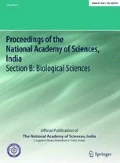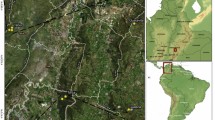Abstract
The historical collections in herbaria are increasingly used for documentation of biodiversity. The use of herbarium reconstruction in the Himalayan biodiversity hotspot, using a case study from Srinagar city in Kashmir Himalaya has been shown. During the present investigation, a comprehensive and updated biodiversity database of 937 plant taxa has been developed, which is based on expert investigation of ca. 45,000 plant specimens deposited in the herbarium of University of Kashmir, and careful supplementation of field records in the study area made over the last one decade. The results indicate a clear dominance of herbaceous growth form as 602 species were herbs. Majority of the plant species possess perennial life span, as 610 plant species fall under this category. Inspite of being a rapidly urbanising centre, Srinagar city owing to its location in the global biodiversity hotspot of Himalayas exhibits a clear dominance of wild-growing plant species. In the database, 20 species fall under different threat categories. The present study is the documentation of plant biodiversity of this eco-fragile mountainous region and clearly demonstrates the precious value of biological collections in bridging the knowledge gaps in global biodiversity hotspots, including Himalayas. Looking ahead, the biodiversity database can serve as a baseline in the conservation and sustainable use of biodiversity; and more importantly, the database can provide the reference framework in assessing and monitoring the impending impacts of land use and climate change on the biodiversity of this Himalayan city.






Similar content being viewed by others
References
New York Botanical Garden (2012) Index Herbariorum: a global directory of public herbaria and associated staff. http://sciweb.nybg.org/science2/IndexHerbariorum.asp. Accessed 18 May 2015
Smith GF, Steenkamp Y, Klopper RR, Siebert SJ, Arnold TH (2003) The price of collecting life—overcoming the challenges involved in computerizing herbarium specimens. Nature 422:375–376
O’Connell AF, Gilbert AT, Hatfield JS (2004) Contribution of natural history collection data to biodiversity assessment in national parks. Conserv Biol 18:1254–1261
Shaffer HB, Fisher RN, Davidson C (1998) The role of natural history collections in documenting species declines. Trends Ecol Evol 13:27–30
Lavoie C (2013) Biological collections in an ever changing world: Herbaria as tool for biogeographical and environmental studies. Perspect Plant Ecol Evol Syst 15:68–76
Zachos FE, Habel JC (2011) Biodiversity hotspots: distribution and protection of conservation priority areas. Springer, Berlin, pp 3–22
Victor JE, Smith GF, Vanwyk AE (2015) A method for establishing taxonomic research priorities in a megadiverse country. Phytotaxa 203:55–62
Paknia O, Rajaei H, Koch A (2015) Lack of well-maintained natural history collections and taxonomists in megadiverse developing countries hampers global biodiversity exploration. Organ Divers Evol 15:619–629
Murti SK, Chowdhery HJ (2000) Plant diversity and conservation in india- an overview. Bishen Singh Mahendra Pal Singh, Dehra Dun
Singh H (2010) Handbook on herbaria in India and neighbouring countries. National Institute of Science Communication and Information Resources, New Delhi
Rao SK, Sringeswara AN, Kumar D, Pulla S, Sukumar R (2012) A digital herbarium for the flora of Karnataka. Curr Sci 102:1268–1271
Dar GH, Khuroo AA (2013) Floristic diversity in the Kashmir Himalaya: progress, problems and prospects. Sains Malays 42:1368–1377
Khuroo AA, Weber E, Malik AH, Dar GH, Reshi ZA (2010) Taxonomic and biogeographic patterns in the native and alien woody flora of Kashmir Himalaya, India. Nordic J Bot 28:685–696
Census of India 2011. http://censusindia.gov.in/. Accessed March 12 2015
Srinagar Developmental Authority. http://www.sdasrinagar.com/index.php?option=com_content&view=article&id=32&Itemid=171. Accessed April 23 2015
Amin A, Amin A, Singh SK (2007) Study of urban land use dynamics in srinagar city using geo-spatial approach. Bull Environ Sci Res 1:18–24
The Plant list. http://www.theplantlist.org/. Accessed May 21 2015
GRIN-Germplasm Resources Information Network. http://www.arsgrin.gov/cgi-bin/npgs/html/index.pl. Accessed June 3 2015
Catalogue of Life 2014. http://www.catalogueoflife.org/col/search/all. Accessed Dec 20 2014
Bentham G, Hooker JD (1862–1883) Genera plantarum ad exemplaria imprimis in herbariis kewensibus servata definita 3 vol. London (Gen.Pl.)
Angiosperm Phylogeny Group III (2009) An update of the Angiosperm Phylogeny Group classification for the orders and families of flowering plants: APG III. Bot J Linn Soc 161:105–121. doi:10.1111/j.1095-8339.2009.00996.x (accessed: 18-06-2015)
Flowers of India. http://www.flowersofindia.net/. Accessed March 19 2015
Flora of North America. http://luirig.altervista.org/floranam/papaver.htm. Accessed May 9 2015
e-floras. http://www.efloras.org/. Accessed July 5 2015
IUCN (2015) The IUCN red list of threatened species. Version 2015-4. http://www.iucnredlist.org. Downloaded on 19 Nov 2015
Nayar MP, Sastry ARK (ed) (1987, 1988, 1990) Red data book of Indian plants, 3 vols. BSI, Howrah
Molur S, Walker S (ed) (1998) Report of the workshop “conservation, assessment and management plan for selected medicinal plants of northern, northeastern and central India” (BCPP- Endangered Species Project) Zoo Outreach Organisation, Conservation Breeding Specialist Group, India, Coimbatore, India, p 62
Rao CS, Suresh BL, Suresh G (2003) Red list of threatened vascular plant species in India. ENVIS, Botanical Survey of India, Ministry of Environment and Forests, Government of India
Secretariat of the CBD (2012) Cities and biodiversity outlook. A global assessment of the links between action and policy: urbanization, biodiversity, and ecosystem services, Montreal, p 64
Dar GH, Khuroo AA, Nasreen A (2012) Endemism in the angiosperm flora of Kashmir Valley, India: stocktaking. In: Mukherjee SK, Maiti GG (ed) Proceedings of international seminar on multidisciplinary approaches in angiosperm systematics, Kolkata, pp 502–519
Walters SM (1970) The next twenty years. In: Perring F (ed) The flora of a changing Britain. Hampton, Classey, pp 136–141
Kühn I, Roland Brandl R, Klotz S (2004) The flora of German cities is naturally species rich. Evol Ecol Res 6:464–749
Celesti-Grapow L, Capotorti G, Vico ED, Lattanzi E, Tilia A, Blasi C (2013) The vascular flora of Rome. Plant Biosyst 147:1059–1087
Khuroo AA, Rashid I, Reshi Z, Dar GH, Wafai BA (2007) The alien flora of Kashmir Himalaya. Biol Invasion 9:269–292
Khuroo AA, Malik AH, Reshi ZA, Dar GH (2010) From ornamental to detrimental: plant invasion of Leucanthemum vulgare Lam. (Ox-eye Daisy) in Kashmir valley, India. Curr Sci 98:600–603
Barthlott W, Biedinger N, Braun G, Feig F, Kier G, Mutke J (1999) Terminological and methodological aspects of the mapping and analysis of global biodiversity. Acta Bot Fenn 162:103–110
Kent M, Stevens RA, Zhang L (1999) Urban plant ecology patterns and processes: a case study of the flora of the City of Plymouth, Devon, UK. J Biogeogr 26:1281–1298
Hobbs RJ (1989) The nature and effects of disturbance relative to invasions. In: Drake JA, Mooney HA, Castri F, Groves RH, Kruger FJ, Rejmánek M, Williamson M (eds) Biological invasions: a global perspective. Wiley, Chichester, pp 389–405
Lake JC, Leishman MR (2004) Invasion success of exotic in natural ecosystems: the role of disturbance, plant attributes and freedom from herbivores. Biol Conserv 117:215–226
Bradshaw WE, Zani PA, Holzapfel CM (2004) Adaptation to temperate climates. Evolution 58:1748–1762
Seto KC, Guneralp B, Hutyra LR (2012) Global forecasts of urban expansion to 2030 and direct impacts on biodiversity and carbon pools. Proc Natl Acad Sci 109:16083–16088
Acknowledgements
The authors are highly thankful to the Honorary Director, Centre for Biodiversity and Taxonomy (CBT) for providing necessary facilities during the course of present study. They greatly acknowledge the kind help rendered by the scholars and supporting staff of CBT, University of Kashmir and preparation of map by Muzafer A. Wani, Department of Geography, University of Kashmir. The insightful suggestions made by two anonymous reviewers which improved the quality of the manuscript are highly acknowledged.
Author information
Authors and Affiliations
Corresponding author
Ethics declarations
Conflict of interest
All the authors hereby declare that there is no conflict of interests in submitting this manuscript to the journal.
Electronic supplementary material
Below is the link to the electronic supplementary material.
Supplementary material 1
Standard terminology for wild and cultivated status, growth form and life span categories. (DOCX 18 kb)
Supplementary material 2
Database of flora of Srinagar arranged alphabetically by family name. (Taxa in the database include the accepted plant name, popular synonyms, English name, wild/cultivated status, growth form and life span. ABBREVATIONS USED: W- Wild, C-Cultivated, CW: Cultivated as well as wild, H-Herb, S-Shrub, T: Tree, G: Graminoid, Ss- Subshrub, V: Vine, A: Annual, B: Biennial, P: Perennial, Syn: Synonym) (DOCX 137 kb)
Supplementary material 3
Plant species with unresolved names recorded from Srinagar and excluded from the database. (DOCX 18 kb)
Supplementary material 4
Occurrence localities of the taxa listed in the checklist of flora of Srinagar, their Accession number (s) in the KASH herbarium and first year of report in Srinagar [NA=Not available] (DOCX 114 kb)
Supplementary material 5
Photographs of threatened plant species (pdf 615 kb)
Rights and permissions
About this article
Cite this article
Mehraj, G., Khuroo, A.A., Muzafar, I. et al. An Updated Taxonomic Inventory of Flora of Srinagar City (Kashmir Himalaya) India, Using Herbarium Reconstruction Approach. Proc. Natl. Acad. Sci., India, Sect. B Biol. Sci. 88, 1017–1023 (2018). https://doi.org/10.1007/s40011-017-0840-5
Received:
Revised:
Accepted:
Published:
Issue Date:
DOI: https://doi.org/10.1007/s40011-017-0840-5




